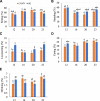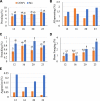Behavior and Immune Response of Conventional and Slow-Growing Broilers to Salmonella Typhimurium
- PMID: 35586720
- PMCID: PMC9108930
- DOI: 10.3389/fphys.2022.890848
Behavior and Immune Response of Conventional and Slow-Growing Broilers to Salmonella Typhimurium
Abstract
Fast growth rate in broiler chickens comes with welfare concerns and the contribution of growth rate to pathogen resistance and sickness behavior is relatively unknown. The objective of this study was to evaluate physiological and behavioral responses of conventional (CONV) and slow-growing (SG) male broilers challenged with Salmonella Typhimurium. CONV (n = 156) and SG (n = 156) chicks were raised in a pen with wood litter shavings until day 7 of age, when birds were transferred to 24 isolators (n = 11 chicks/isolator). On day 14 of age, half of the birds (n = 12 isolators) were challenged with S. Typhimurium (ST) and the other half (n = 12 isolators) received a control (C). On days 7, 13, 17, 21, and 24, body weight was recorded, and blood, jejunum and ileum sections were collected from 2 birds/isolator (n = 48 birds/sampling) to measure plasma IgA and IgG and intestinal histomorphology, respectively. On days 12, 16, 21, and 23, video was recorded to evaluate bird postures (sitting, standing, or locomoting) and behaviors (eating, drinking, preening, stretching, sham foraging, allopreening, and aggression). CONV birds were 70 g heavier (p = 0.03) on day 21 and 140 g heavier (p = 0.007) on day 24 than SG. On day 7, CONV jejunum villus height and crypt depth were 22 and 7 μm greater (p ≤ 0.001), respectively, than SG. On day 24, ST ileum villus height was 95 μm shorter (p = 0.009) than C. IgA increased after day 17 for all birds and at day 21, CONV IgA was greater (p = 0.01) than SG. Although SG IgG was 344 μg/ml greater (p = 0.05) than CONV on day 7, CONV IgG increased with age (p < 0.0001) to greater (p ≤ 0.03) concentrations than SG on day 21 and day 24 by 689 μg/ml and 1,474 μg/ml, respectively, while SG IgG remained at similar concentrations after day 13. Generally, a greater proportion of birds sham foraged as they aged (p < 0.0001). A greater proportion of CONV tended to sit (p = 0.09) and fewer locomoted (p < 0.0001) than SG as they aged. The results illustrate conventional and slow-growing broilers differ in their behavior, immunity, and response to Salmonella.
Keywords: Salmonella; behavior; broiler; growth rate; immune response.
Copyright © 2022 Snyder, Riley, Robison, Karcher, Wickware, Johnson and Weimer.
Conflict of interest statement
The authors declare that the research was conducted in the absence of any commercial or financial relationships that could be construed as a potential conflict of interest.
Figures






Similar articles
-
Ileal and cecal microbiota response to Salmonella Typhimurium challenge in conventional and slow-growing broilers.Front Physiol. 2022 Oct 4;13:971255. doi: 10.3389/fphys.2022.971255. eCollection 2022. Front Physiol. 2022. PMID: 36267582 Free PMC article.
-
Effects of genetic strain, stocking density, and age on broiler behavior.Poult Sci. 2025 Feb;104(2):104723. doi: 10.1016/j.psj.2024.104723. Epub 2024 Dec 24. Poult Sci. 2025. PMID: 39740497 Free PMC article.
-
Differences in carcass composition and meat quality of conventional and slow-growing broiler chickens raised at 2 stocking densities.Poult Sci. 2022 Jun;101(6):101833. doi: 10.1016/j.psj.2022.101833. Epub 2022 Mar 9. Poult Sci. 2022. PMID: 35421814 Free PMC article.
-
Differences in performance, body conformation, and welfare of conventional and slow-growing broiler chickens raised at 2 stocking densities.Poult Sci. 2020 Sep;99(9):4398-4407. doi: 10.1016/j.psj.2020.06.009. Epub 2020 Jun 25. Poult Sci. 2020. PMID: 32867983 Free PMC article.
-
In pursuit of a better broiler: walking ability and incidence of contact dermatitis in conventional and slower growing strains of broiler chickens.Poult Sci. 2022 Apr;101(4):101768. doi: 10.1016/j.psj.2022.101768. Epub 2022 Jan 31. Poult Sci. 2022. PMID: 35245808 Free PMC article.
Cited by
-
Fowl Typhoid Outbreak on a Commercial Turkey Farm in Croatia.Microorganisms. 2024 Jan 13;12(1):165. doi: 10.3390/microorganisms12010165. Microorganisms. 2024. PMID: 38257990 Free PMC article.
-
Lysophospholipid Supplementation in Broiler Breeders' Diet Benefits Offspring's Productive Performance, Blood Parameters, and Hepatic β-Oxidation Genes.Animals (Basel). 2024 Oct 24;14(21):3066. doi: 10.3390/ani14213066. Animals (Basel). 2024. PMID: 39518789 Free PMC article.
-
Ileal and cecal microbiota response to Salmonella Typhimurium challenge in conventional and slow-growing broilers.Front Physiol. 2022 Oct 4;13:971255. doi: 10.3389/fphys.2022.971255. eCollection 2022. Front Physiol. 2022. PMID: 36267582 Free PMC article.
-
Beneficial effects of Alterion supplementation on growth metrics, intestinal histomorphology, and microbial communities in indigenous and commercial chicken breeds.Front Vet Sci. 2025 Jul 11;12:1630712. doi: 10.3389/fvets.2025.1630712. eCollection 2025. Front Vet Sci. 2025. PMID: 40717914 Free PMC article.
References
-
- Aviagen (2018). Ross Broiler Management Handbook. Available at: https://en.aviagen.com/assets/Tech_Center/Ross_Broiler/Ross-BroilerHandb... (Accessed December 1, 2021).
-
- Aviagen (2019. ). Ross 308 Performance Objectives. Aviagen Available at: https://en.aviagen.com/assets/Tech_Center/Ross_Broiler/Ross308-308FFBroi... (Accessed July 14, 2021).
LinkOut - more resources
Full Text Sources
Miscellaneous

